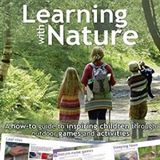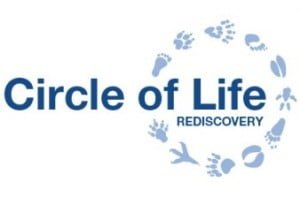One great book and five great reasons to teach core curriculum subjects Outside the Classroom.
Learning with Nature is aimed at inspiring and supporting adults to get outdoors with young people aged 3 to 16 years old.
“This book offers a chance to the youth of today and the nature of tomorrow. It has a wealth of structured, tried and tested projects, ideas and games all designed to allow children to breathe fresh air and engage personally with a real world where their minds and bodies can develop and bloom, burst into life and inspire them to love life.” Chris Packham, March 2014.
“For the first time I am meeting teachers who have themselves never played or enjoyed the outdoors during their childhood. They don’t know what to ‘do’, and place a low value on the outdoors as a learning environment. We know young people today are spending hours on video games, and that their roaming radius has reduced by about 70% since the 1950s with the consequent rise in levels of obesity, mental health issues and isolation.” Marina Robb, Author and Founder Circle of Life Rediscovery.
Why is this book important?
This book makes it possible for parents and teachers to get outdoors. It aims to capture the imagination of families and contribute to reversing the current ‘indoor’ trend. It provides a valuable resource for educators to deepen and expand what they already offer.
SPECIAL OFFER AVAILABLE NOW – £12.00 + POSTAGE. CLICK HERE TO ORDER.
1. THE ‘WOW’ MOMENT
Natural environments can transform individual and school performance. Nature can provide a fantastic Wow! moment for your lesson, to bookend your key learning outcomes, and to support them. Children have an innate fascination about nature. It may be soaking in an atmospheric place in your local park or nature reserve as a stimulus for creative writing, or estimating measurements or volumes of areas, spaces, trees or ponds as a basis for maths. The outdoors facilitates strong emotional memories and aids learning. Play outdoors can be physical, explorative, constructive, imaginative and creative.
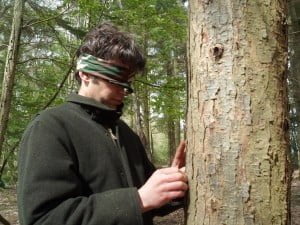 There are many adventurous activities to be had in the outdoors that do not necessarily conform to normal activities such as climbing trees and playing outdoor games. Evidence shows that learning in natural environments can transform individual and school performance by increasing the standards of teaching and learning, allowing innovation, creativity and excellence in curriculum delivery, as well as increasing motivation and attainment.
There are many adventurous activities to be had in the outdoors that do not necessarily conform to normal activities such as climbing trees and playing outdoor games. Evidence shows that learning in natural environments can transform individual and school performance by increasing the standards of teaching and learning, allowing innovation, creativity and excellence in curriculum delivery, as well as increasing motivation and attainment.
For example, The Natural Connections Demonstration Project was set up as one of the largest outdoor learning projects in the UK. The Project approach and design is informed by the latest insight research of teachers needs, evidence of barriers and benefits of learning in natural environments and best practice models for engaging volunteers.
Wherever your outdoor classroom is, find resources to help bring the lesson to life: https://www.countrysideclassroom.org.uk/
- Case Study: Developing children’s learning through work in the natural environment from Preesall Fleetwood’s Charity Church of England Primary School.
“The initiative started as a way of engaging a small group of boys who were underachieving and were not keen to be at school. These boys showed an interest in the natural environment and we capitalised on this by providing practical learning sessions working outdoors in the school grounds and woods. The results were fabulous. They continued to work in the school grounds during their lunch periods and they had a reason to come to school. Their attitudes improved, which carried over into their school work and their achievement at level 4 was better than expected. The ‘forest school’ and wider environmental work are now integral parts of this school’s work.”
John Belshire, Headteacher.
- The good practice in detail.
Inspectors identified the ‘forest school’ as an outstanding feature of environmental education at the school. All the children are involved in activities in the outdoors and in the woodland, but it is the youngest and oldest children who spend most time there. Children are allowed to climb trees and build fires. They listen to the heartbeat of trees (sap rising), and identify bird songs. They make and use tools ranging from potato peelers to knives, axes and mallets. They make environmental art, maintain the grounds and plant trees. There is a thriving ‘bug hotel’ and older children are involved in more complex tasks such as hedge-laying and pond maintenance.
While it’s clear that pupils’ knowledge and understanding of the environment improves, Julia Crompton, the school’s ‘forest school’ teacher, identifies the real benefits of this outdoor learning as:
- Increased self-esteem
- Improved social skills
- The development of language and communication skills
- Improved physical motor skills
- Improved motivation and concentration.
![]() “We focused on the natural environment provided by the school grounds as a learning opportunity and a way to enrich children’s experiences. The grounds were originally established about 15 years ago but had not been actively used by the children. They were used for science lessons and the greenhouse was used for growing some plants but we found opportunities to do much more. It has been made easy by the enthusiasm and the expertise of staff and is now a regular part of this school’s work.”
“We focused on the natural environment provided by the school grounds as a learning opportunity and a way to enrich children’s experiences. The grounds were originally established about 15 years ago but had not been actively used by the children. They were used for science lessons and the greenhouse was used for growing some plants but we found opportunities to do much more. It has been made easy by the enthusiasm and the expertise of staff and is now a regular part of this school’s work.”
John Belshire, Headteacher.
Children enjoy taking risks, but the school recognises that safety is paramount. Skills are learnt carefully and safety equipment is always used. By its nature, practical work is not a mass participation activity. Children work in groups of around six at a time to ensure that they have a quality learning activity which is safe. Once the children have been taught to use tools, they will expand the quality of their ideas and plans because the range of what they perceive to be possible has expanded.
Case Study: The Chicken Project – Beechwood Primary School
“The chickens have slowed us down, they make us stop and stare’. Staff report that the children are quieter and calmer around the chickens and the whole school benefits because the aviary is right in the centre of the school.
Learning Objectives
We were looking for ideas to motivate the children to write, through cross curricular contexts and to inspire the teachers to revisit the planning and incorporate child-centred, compelling learning experiences. We were also hoping to engage the parents through homework and in school activities.
Pupil Learning Outcomes
Increased empathy and awareness of other living creatures. Awe and wonder of nature as the chickens hatch from eggs. Imagine the children writing from the perspective of the chick hatching form the egg…incredible! Confidence building, you can email a company to ask for fundraising money or telephone the manager of the local Coop to fund our coop! And many, many more!
What lessons have teachers / the school learned from the project / activity?
Ofsted like Learning in the natural environment! Our recent Ofsted report for which we received a ‘good’ included this statement: ‘Pupils are keen to undertake responsibilities such as looking after the school chickens.’ Staff discovered that children engage better with their learning when they are immersed in and have a personal connection with the theme. Money is no object, fund raising large sums of money is possible. With enough enthusiasm you can achieve anything!
2. ADDRESS DIFFERENT LEARNING STYLES
We are programmed to interact with our environment in useful ways. Being outside provides opportunities to address different learning styles, in particularly kinesthetic learners can excel as they use their bodies differently to learn. Getting all children off their seats is a great way to stretch their capacities to learn in different ways. All the senses are stimulated, the colours, textures, shapes, smells, sounds awaken our awareness and develop our skills to navigate their surroundings.
Physical Development has become one of three key areas in the Early Years Foundation Stage guidance and this is a golden opportunity for introducing Outdoor Learning. The things children do in their bodies and the way they are physically in their everyday life massively affect the way they develop, the things they can learn and how they feel about themselves.
The developing human animal is biologically programmed to get what it needs. We are programmed to interact with our environment in useful ways. Thus a low brick wall invites us to walk along it; a tree (or a chair, or an adult’s body) suggests we climb or hang off it; a large open space tells us to run. These aren’t decisions, they’re instincts, imperatives – because we must run and climb and spin and roll to grow the body systems we need for all that life asks of us in future. These instincts come before any complex intellectual or social skills. They underpin them – and our bodies know it. In the rough and tumble, run, spin, tip and roll of movement play we grow the foundations for our health, our wellbeing and our capacity to learn things.
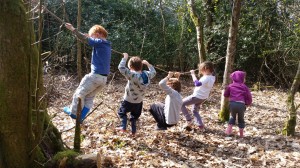
Children’s bodies matter to their learning
Proprioception (sense of body) provides feedback of where one part of our body is in relation to the others and how we feel in our bodies.
We are compelled to get this sense in place before we can concentrate on anything else. (Think of the day you break a tooth, and how your tongue is compelled to feel it out over and over until you have a new sense of your body, without that bit of tooth.) Developing our vestibular system (the thing that monitors our relationship with gravity and the ground beneath us), must come before any more complicated physical or mental skills we might acquire in PE lesson or in the classroom. It provides a sense of, and security in, our relationship with the world around – being in balance or equilibrium. Spinning is an excellent vestibular workout. As it happens, it also helps prepare the eyes for reading.
“We humans are, first and foremost, physical creatures. Our body is our first home. Movement is our first language. Children need support to notice, speak and work with their first language first. But our early years framework simply doesn’t reflect this. The Early Learning goals made by people who don’t move freely, for people who do (i.e. small children). When we support children to move spontaneously and freely, the learning they do far exceeds the lowest common denominators of ‘balance and coordination’ and ‘fine and gross motor’ skills, but our education culture skips over anything to do with embodied learning and we never make up the lost ground.”
If you’re not convinced, try this exercise
Put a pen in the hand you don’t write with, and write a sentence. Notice how it feels to do this, how unfamiliar and odd; how difficult it is to make your hand do what you want it to. Now write the same sentence with the hand you usually use. The feelings will be very different – full of comfort and ease; above all – familiarity.
For writing to work well, we need this familiarity. We need to be able to fall into the physical pattern without thinking about it; for our body to feel ‘right’ as we carry out the task so that we don’t have to think about it. This ‘rightness’ is provided by our proprioceptive sense, the sense of where one body part is in relation to another. (And practice of course.) This sense also controls our sense of how much force we need to hold the pencil between our fingers and pushing the pen over the paper.
Writing practice is important. But as important is the movement play that builds a felt sense of the hand, wrist, arm, shoulder and back.
This is one example of the importance of senses and the development of our well-being. For more information about the above please go to: https://www.jabadao.org/?blog=
A different set of learning goals for Physical Development for babies and children:
Display a strong inner drive to explore themselves, each other and the world around through physical interactions, movement play of their own devising and physical engagement with the environment.
Are on the move for the majority of their day – moving in lots of different ways (with gusto and abandonment; care and precision; outer and inner focus; on their own, in relationship to internal and external factors, on the floor, in small and large spaces, indoors and out).
Show pleasure in being physical and know what to do to feel good in their bodies.
Show growing understanding of how to take care of themselves and other people as they actively engage in physical exploration and play.
Know how to find and use resources to extend their movement play; and how to involve adults and peers in developing their physical play.
Can make the world work for them, manipulating objects and negotiating the environment with purpose and focus, in the ways they intend; they are able to persist through physical challenges and show the determination to acquire new skills and abilities.
Show a growing ability to balance highly physical activity with rest and quieter activity.
Show a developing security and confidence in their physicality through:
- A growing sense of their own body (proprioception).
- Increasing security in their relationship to gravity (vestibular sense).
- Ease with touch and being touched (tactile sense).
- Recognition of pain, heat, cold and hunger and appropriate responses.
- A growing awareness of the feeling of the inside of their body (interoception) and appropriate responses.
- A steadily developing stability and motor control in their chosen physical actions.
Take pleasure in sharing a range of discoveries made through physical play – in movement, in vocal and verbal responses, in visual representations.
Value movement play as an important part of their day and show high levels of wellbeing as they engage in it.
Use information gained through the languages of the body – sensation, feeling, movement, instinct and image – to work out how the world works, in communicating their experience, in problem solving and in becoming confident, happy, full-bodied people.
3. GET GREAT SMSC IDEAS….ANIMAL RIGHTS?
Address Social, Moral, Spiritual and Cultural education requirements by observing and discussing other beings: the animals and plants around us have the right to a home and habitat that suit them, but what do we do when humans need homes and transport? The opportunities to hone children’s awareness of moral dilemmas around the natural world in the city are ample. Consider how reliant humans are on tools and resources, whilst the non-human world interacts without additional resources such as clothes, fire, etc.
Thinking skills with mind and body
We need to prepare children to be flexible and adaptable members of the workforce by virtue of their abilities to think laterally, creatively and sustainably. Our culture prizes intellectual skills over physical instincts. And so we constantly try and override the inbuilt instinct to be a body in the name of ‘ordered learning environments’ and acquisition of intellectual skills. We seek to tame the body, contain it, use it like a sort of vehicle to carry us quietly to the more important things in our lives. And in so doing, we miss the obvious. Our future responsibility according to Sara Knight (2013) is to children who will be dealing with environmental and climate change. To teach, ‘science and geography about individual’s place in the globalised society. In the English National Curriculum Consultation Document Feb 2013 there is nothing mentioned about how we as individuals and society as a whole interact with these processes, such as resource depletion, and the impacts on the natural world upon which we depend for all our lifestyles not about climate change, and how we can influence and care for these key processes’.
One of the biggest issues we face today is this sense of being un-rooted; disconnected from natural world. It’s a huge problem that we face now across the whole of society. It’s to do with that deep relationship, it’s to do with what sociologists describe as a ‘profound sense of alienation’ between the majority of human beings and the natural world that sustains us and makes life possible for us.
“This has been creeping up on us for many decades. Now, does this really matter? You might say that there are many more important things to be attending to. Why would we bother about this when we have so many front of mind topical, hard issues to do with society today. For me, this is a really difficult issue, because unless we get to some of these deeper concerns, much of what we do around the specific campaigning issues will not be rooted in the current reality of where we are today. Will not be grounded in that reality.” Jonathan Porritt 2013, Outdoor Learning Conference in Sussex.
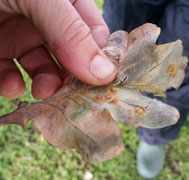
We have to take a wide approach to give us a sense of deeper insights into those whole complicated relationships inside the wider system. To begin, you can discuss ‘Ecosystem Services’ as a way of recalibrating and re-understanding people communities and place.
What do some of these ecosystems mean? There is a growing school of economists who seek to put a value on each of these ecosystem services. What is the value to human kind of the free work done on our behalf? Like all those insects, birds, bees, bats… all those creatures that just as part of their life carry on, carry on this pollination work for us. Try and tot up the X billions of pounds which we would have to find to pay for man made, human-made pollination services to replace the natural pollination.
There are first steps in schools to build a visceral relationship to the world around them. How many species of flora and fauna do you know about in your school grounds? The name is the least important bit, what are the colours, shapes, patterns, the medicines, the smells, where does it like to grow and live, what is the relationship between that plant and the insects and mammals. Start small.
4. CREATE GOOD RELATIONSHIPS
Change the relationships in a conflict-ridden class by taking them to do different activities outdoors, such as learn to light fire or build a den. They will need to cooperate differently, make decisions, use different skills and engage in a stress-reducing environment, all of which can deflect tension built up in classroom conflicts. The outside environment is a great leveler, where children can be valued and find different strengths and roles within a group. Discipline and attention are increased, alongside the performance and ability of children.
Relationships between children can be challenged and deflected by exposing a group to tasks that stretch and stimulate them in different ways. Being outdoors can exercise children’s powers of observation, patience, alertness, courage and physical coordination, which are skills which in the familiar classroom are not so easy to exercise. If you go to a local outdoor area, a park with wild parts, a nature-reserve or even a cemetery, here are some activities which could work:
Make a colour bracelet. This works well in autumn when there are lots of beautiful dead leaves around. Give each child a strip of paper with double-sided sticky tape covering one side. It should be long enough to wrap around their wrist, like a bracelet or a cuff. They should stick on pieces of natural material of a similar colour as possible, once they take off the cover of the sticky tape. This will make them observe intensely the foliage around them. You can give a prize for the one with the closest colours, or to the most beautiful one. This activity works with almost any age group.

Patience is enormously enhanced by wildlife observation. Download bug identification sheets, great ones are available from Holland Park ecology centre here: https://www.rbkc.gov.uk/PDF/Minbeasts%20pack.pdf tell the children they are to find a certain number of creatures on their sheet, and give them a good amount of time to do it.
This activity is best done on a nature reserve or with specialist support if you aren’t confident with either the species or the tools needed to find them. On a small scale, however, it can be done very simply with magnifying glasses.
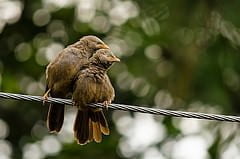
A bird-count. Make children sit in small groups in wild areas for a period of time that will challenge their patience, and ask them to observe as many birds as possible. Spring is a good time to do this.
Give them brownie points if they see birds eating, or roosting or communicating: behaviours which will prove that they were patiently and quietly observed for a time by the children.
In an area with various trees, get the children into small groups, and tell each of them to make friends with a tree. They should notice its size, its texture, its bark, its smell and how the ground around its roots is. Then, one child is blindfolded and the others should turn them around and support them to re-find their friendly tree, based on their tactile and perceptual memories.
A game where children are asked to move around a wild area unobserved is incredibly exciting for children, and encourages stealth, silence, focus, concentration and care in the environment. There are lots of such games that could be adapted, but one could be the retrieving of secret items or messages to complete a story, or moving around a quiet obstacle course without alerting the opposite team.
Making a wormery can be a challenge for those who don’t like creepy crawlies. Give a prize to people who are able to pick up worms and move them around. Jumping on a piece of land to encourage the worms to come up, then put them in a wormery to observe how they make tunnels and can quickly mix soil and create compost. There is lots of advice online about how to create a wormery. The great advantage of worms is that they eat any organic matter, and they can easily be released into the school grounds if caring for them becomes too onerous, or in the holidays.
Exposure to nature calms us, lowers our heart rate and lowers cortisol, the stress hormone, in the blood, making us less likely to create conflict or lose our tempers. This is entirely relevant to children as well as to adults.
The outdoors is also a great place for teachers to observe children in new surroundings, and gain possibly new insights into their development and how they handle challenge and conflict, which can be useful in supporting individual children with difficulties in future, or gaining learning on how to manage a difficult class when back in conventional surroundings. A useful web-page on handling conflict with young children can be found here: https://www.communityplaythings.co. uk/learning-library/articles/childrenand-conflict-in-the-classroom
Berlin’s playgrounds: how to reduce urban violence through play An interesting case study is that of West Berlin’s playgrounds in the 1980s. West Berlin had long been almost surrounded with Soviet-occupied land, leaving little space for Berliners to enjoy nature. At the same time, the incidence of child and adolescent violence in Berlin’s schools was unacceptable. The education authorities undertook a very wise 20-year programme of transforming the city’s school playgrounds to make them more variant, more rich in nature and employing inspiring strategies to present choice, space, intimacy, creativity and inspiration to the spaces. They are profiled in a series of documents by Learning through landscapes, who have worked with Scottish schools to learn from Berlin and try to implement the same strategies in other conflict-ridden areas. The documents can be downloaded here: https://www.ltl.org.uk/spaces/casestudy.php?cs=31
5. BECOME AN OFSTED ‘OUTSTANDING’
Ofsted highly prizes teaching methods that include creativity and originality and engage pupils’ imaginations. Using the outside creatively could contribute to earning imaginative teachers ‘outstanding’ status at their next inspection, leading to higher status in their school and possible career enhancement.

In particular, taking learning outside and following some of the activities above can combat the dreaded ‘teacher domination’, in which the teacher falls back on ‘talk and chalk’ methodology for teaching.
We know that sometimes direct spoken delivery of information is necessary, but the outdoor environment is one that directly contrasts the traditional arena of the blackboard-focused teaching style, and is thus likely to impress an inspector who sees teachers doing it. If you are in danger of overloading your daily curriculum delivery with teacher-talk, starting to become confident with the outdoors as a great arena for group work, independent work, creative child-centred collaborative work is a fantastic way to develop your classroom range towards Outstanding status.
Ofsted clarified, in a recent document, that they do not judge teachers’ performance on small snippets of observation, but want to collate an overall impression drawn from pupils’ work, talking to pupils and assessing their attitude to learning, observing behavior and teachers’ style with their class, as well as their evidence of practical preparation, book-marking, classroom displays and collaboration with support staff. All these can be supported by taking learning outside, in the following ways, in particular with regard to the animated and engaged way children who have enjoyed outdoor learning consistently will speak in way about it to any adult questioner, giving a great impression of their attitude to learning.

Marina Robb
Founder & Director, Circle of Life Rediscovery
www.circleofliferediscovery.com | 01273 814226 | [email protected]
We provide nature based experiences and programmes that are educational, fun and often life-changing. We run funded projects with our partners that directly support health and well-being for vulnerable members of our society.
We offer days for schools or family days in the woodlands and bespoke residential camps and Forest Schools. You can gain a qualification in leading your own Forest School programme; improve your knowledge and skills with our adult training CPD days.


